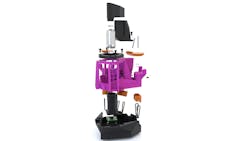Laboratory-grade optical microscope can be 3D-printed for $19
Labs around the world can now 3D print their own precision microscopes to analyze samples and detect diseases, thanks to an open-source design created at the University of Bath (Bath, UK).1 The OpenFlexure microscope is a fully automated, laboratory-grade instrument with motorized sample positioning and focus control and produces high-quality images. It has been designed to be easy to use, with a software interface and simplified alignment procedures. It is also customizable, meaning it can be adapted for laboratory, school and home use.
Related: High-resolution 3D printed microscope is promising for medical diagnostics in developing countries
The Bath design is a lot more affordable than a commercial microscope, both in terms of the upfront cost and the maintenance costs of the equipment. A commercial microscope intended for lab use can sell for tens of thousands of British pounds. An OpenFlexure microscope can be constructed for as little as £15, or about US $19 (this would cover the cost of the printed plastic, a camera, and some fastening hardware). A top-end version would cost a couple of hundred pounds to produce and would include a microscope objective and an embedded Raspberry Pi computer.
Capabilities can include trans- and epi-illumination, polarization contrast imaging, and epiflourescence imaging. The flexure-based positioning stage for the microscope provides three-axis positioning with step sizes as small as 50 nm in the z axis and 70 nm in x and y.
Joel Collins, co-creator of the microscope and physics researcher at the University of Bath, says, “We want these microscopes to be used around the world -- in schools, in research laboratories, in clinics and in people’s homes if they want a microscope just to play with. You need to be able to pick it up and use it straight away. You also need it to be affordable.”
To date, more than 100 OpenFlexure microscopes have been printed in Tanzania and Kenya, demonstrating the viability of a complex piece of hardware being conceptualized in one part of the world and manufactured elsewhere.
Co-creator Richard Bowman says, “Our Tanzanian partners, STICLab, have modified the design to better suit their local market, demonstrating another key strength of open source hardware – the ability to customize, improve, and take ownership of a product.”
Source: https://www.bath.ac.uk/announcements/print-your-own-laboratory-grade-microscope-for-15/
REFERENCE:
1. Joel T. Collins et al., Biomedical Optics Express (2020); https://doi.org/10.1364/BOE.385729.
Got optics- and photonics-related news to share with us? Contact John Wallace, Senior Editor, Laser Focus World
Get more like this delivered right to your inbox
About the Author
John Wallace
Senior Technical Editor (1998-2022)
John Wallace was with Laser Focus World for nearly 25 years, retiring in late June 2022. He obtained a bachelor's degree in mechanical engineering and physics at Rutgers University and a master's in optical engineering at the University of Rochester. Before becoming an editor, John worked as an engineer at RCA, Exxon, Eastman Kodak, and GCA Corporation.

